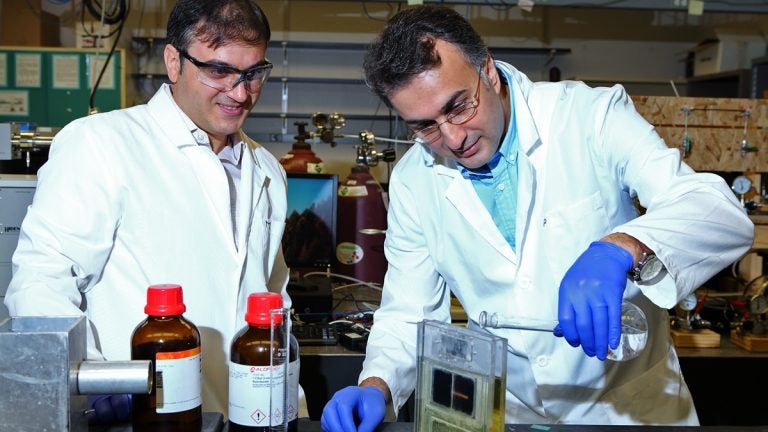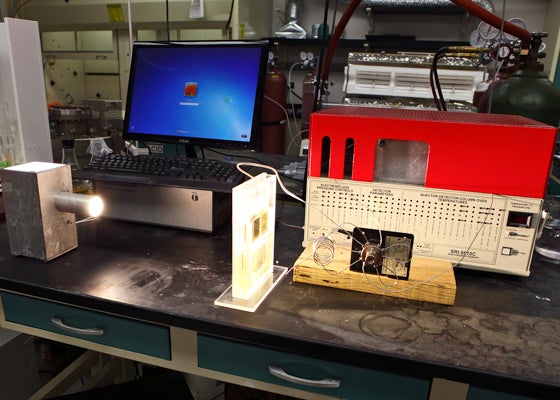Mimicking nature, an artificial leaf can recycle CO2
Listen 4:19
Right, Amin Salehi-Khojin, assistant professor of mechanical and industrial engineering, and left, postdoctoral research associate Mohammad Asadi. (Courtesy The University of Illinois at Chicago)
An artificial leaf created by researchers at the University of Illinois at Chicago captures greenhouse gas and puts it to work again.
Carbon dioxide (CO2) is one of those greenhouse gases that builds up in the atmosphere, trapping heat across the earth and contributing to global warming.
CO2 is a natural part of the environment. Humans and other animals breathe it out, and plants take it in during photosynthesis. Cars and factories also spew CO2 as they burning fossil fuels, but those emissions are more CO2 than nature is equipped to deal with.
So what if scientists could build a machine, using nature’s example, to help clear out some of that greenhouse gas? What if the machine could not only clear it out, but also turn it into usable fuel?
Mechanical engineer Amin Salehi-Khojin and his team have done that in partnership with researchers from Argonne National Laboratory.
“The natural photosynthesis process uses carbon dioxide from the air, and the water, and the energy from the sun, and converts it to food like, sugar,” said Salehi-Khojin, a researcher at the University of Illinois at Chicago.
“We want to take the carbon dioxide from the air, and use the energy from the sun, rearrange the chemical bonds of the carbon dioxide, then we can take it to anyplace, we can burn it any time,” Salehi-Khojin says.
This process takes place inside an “artificial leaf.” Think of it like hacking nature.
Other science teams around the world are working on their own artificial leaf projects, but each group has a different approach.
Salehi-Khojin and his team are mimicking what leaves do but tweaking the process to simultaneously clear pollution from the air and produce energy.
Artificial photosynthesis is a new kind of carbon cycle that can produce fuel to power our cars or homes.
An artificial leaf is basically a solar cell, much like you might find in a solar panel on a roof. It stands upright and is about the size of a hardcover book. The machines uses solar power to break down CO2 into the two parts it’s made of—carbon and oxygen.
Salehi-Khojin says the real workhorse inside the artificial leaf is a custom-made liquid catalyst, which is very efficient at splitting up the CO2.
Once it’s broken down, the leaf rearranges the molecules in CO2 to store it as a synthetic gas. That gas can later be burned or converted into other types of fuel.

Although the artificial leaf can recycle some of the carbon we pump into the atmosphere from vehicles and factories, making it a source of renewable energy, it’s not necessarily clean fuel. That’s because the synthetic gas it produces and stores can be turned into the same types of fuel that come out of a gas pump.
But the leaf isn’t adding a new pollution to the atmosphere, because it captures greenhouse gas produced by fossil fuels and puts them to work again as energy. Researchers call this ‘carbon neutral.’
“The beauty of this concept is that the carbon level is going to be constant,” Salehi-Khojin says.
Picture a field full of these artificial leaf solar cells, powered by sunlight, grabbing CO2 from the air and turning it into fuel. Salehi-Khojin says they could be positioned next to smokestacks to capture runoff CO2 or in a sunny park.
The real challenge with renewable energy sources like this one is making a fuel that’s competitive with “Big Oil” prices. Right now, solar and wind energy aren’t quite making the cut, but they’re getting closer.
Salehi-Khojin says the artificial leaf is capable of becoming a source of renewable energy that could produce fuel at roughly the same cost as gasoline today.
“My belief is that in the next five to seven years, we can make a prototype of the large scale conversion of carbon dioxide to fuel for the cost of two dollars per gallon,” he said.
The important difference between the artificial leaf and other types of renewable energy is that power sources like solar and wind don’t do anything to clear CO2 already in the atmosphere, Salehi-Khojin says.
The Chicago team already knows their leaf system works on a small scale in the lab, so if they could get a large company like Exxon or BP interested, the next step would be to scale it up.
The big dream is to pull a renewable energy solution to global warming literally from thin air.
WHYY is your source for fact-based, in-depth journalism and information. As a nonprofit organization, we rely on financial support from readers like you. Please give today.






